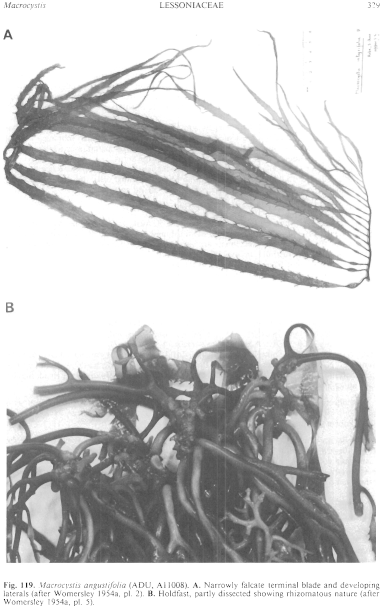|
|
|
|
|
|||||||||||
|
Electronic Flora of South Australia Species Fact Sheet
Phylum Phaeophyta – Order Laminariales – Family Lessoniaceae
Selected citations: Womersley 1954a: 119, pls 2,5,6; 1967: 247.
Thallus (Fig. 119A) medium to dark brown, 2–6(40) m long, with several fronds, bearing narrow blades, from the holdfast. Holdfast (Fig. 119B) broadly conical, (5–) 10–30 cm high and across, composed of entangled, terete or slightly flattened stoloniferous branches 4–8 (–10) mm across with subdichotomous haptera arising on all sides but more so along the lateral margins; epilithic. Stipes arising from the stoloniferous holdfast branches, several from each holdfast, each with 1–3 subdichotomies, terete, 3–5 mm in diameter, above 2–10 m long with unilateral blades. Terminal blades (Fig. 119A) usually narrowly falcate, with 2–8 young lateral blades in progressive stages of differentiation; terminal blade and attached segments L/B 6–10. Lateral blades (Fig. 119A) ligulate, 20–100 cm long and (0.5–) 1–2.5 (–5) cm broad, smooth to rugose, with denticulate margins, teeth 1–5 mm long, basally stipitate with pyriform to very elongate pneumatocysts, (1–) 3–20 cm long and (0.5–) 1–3 cm in diameter. Structure of blades with a central, narrow, filamentous medulla and a broader cortex of isodiametric cells with a surface meristoderm; stipe with an outer medulla containing sieve-tube like elements running longitudinally amongst the hyphae, and with numerous, small, mucilage canals with secretory cells in the outer cortex.
Reproduction: Reproduction from rounded to elongate sori (Fig. 121F) on small blades attached to the lower stipes, usually covering most of the width of the blade; unilocular sporangia clavate, 30–50 µm long and 7–10 µm in diameter, accompanied by larger paraphyses 60–90 µm long and 6–10 µm in diameter, with a gelatinous covering to the sorus.
Type from "Nouv. Holl." (La Billardière); in Herb. Bory, PC.
Selected specimens: Robe, S. Aust., upper sublittoral (Womersley, 30.viii.1949; ADU, A11008; 19.xii.1949; ADU, A16088; and 20.xii.1953; ADU, A57134). Bridgewater Bay, Vic., upper sublittoral ( Womersley, 28.i.1964; ADU, A28058). Point Cook Jetty, Port Phillip, Vic. (Macpherson, 12.vii.1959; ADU, A24620). Walkerville, Vic., drift (Pope & Bennett, 19.v.1949; ADU, Al2194). Bastion Point, Mallacoota, Vic., drift (Womersley, 11.viii.1959; ADU, A23123). Hunter I., N.W. Tas., upper sublittoral (Bennett, 14.i.1954; ADU, A19675). Remine, Tas., upper sublittoral pools ( Wollaston & Mitchell, 25.ii.1964; ADU, A27496). West Head, Stanley, Tas., upper sublittoral (Bennett, 30.i.1955; ADU, A20586).
Distribution: From Margaret Brock reef, Cape Jaffa, S. Aust., to Walkerville, Vic. (with drift plants as far north as Bondi, N.S.W.), and the north and N.W. coasts of Tasmania, from low tide level to 10 m deep. Drift specimens are also known from Kangaroo I. and the southern gulf region in South Australia, between Dec. and April, brought from Robe or further south by the summer current from Tasmania to as far west as Kangaroo I.
South Africa (S.W. coast of Cape Province, from the Olifants R. to Cape Point). Recorded from California by Neushul (1971, p. 221) but doubtfully specifically identical (see also Abbott & Hollenberg 1976, p. 257).
Taxonomic notes: Gametophytes 100–300 µm across, filamentous, the female (Fig. 121G) with few branches and cells mostly 10–15 µm in diameter, forming eggs in terminal cells, the male (Fig. 121H) much branched, cells 5–8 µm in diameter, with small, lateral antheridia.
A collection of 7 sheets, with a loose label "Bondi, N.S.W. July 1901", in NSW, is of specimens with good apices and one juvenile plant with a holdfast. However, M. angustifolia is not known growing on the N.S.W. coast.
While most Australian specimens of Macrocystis can be distinguished as either M. pyrifera or M. angustifolia on the above characters, some from northern and sheltered south-eastern Tasmanian coasts show intermediate characters and are difficult to place. Further studies of their variation around Tasmania are needed, but in general M. pyrifera is attached in deeper water (more than 6 m) and M. angustifolia in shallow water (0–10 m deep).
References:
ABBOTT, I.A. & HOLLENBERG, G.J. (1976). Marine Algae of California. (Stanford Univ. Press: Stanford.)
BORY DE ST-VINCENT, J.B. (1826b). Macrocyste. Dict. Class. d'Hist. Nat. 10, 8–10.
BORY DE ST-VINCENT, J.B. (1826c). In Duperrey, L.I., Voyage autour du monde-Coquille. Atlas. Vol. 2(1), Plates 1–38. (Paris.)
NEUSHUL, M. (1971). The species of Macrocystis with particular reference to those of North and South America. Nova Hedwigia 32, 211–222.
WOMERSLEY, H.B.S. (1954a). The species of Macrocystis, with special reference to those on southern Australian coasts. Univ. Calif Publ. Bot. 27, 109–132.
WOMERSLEY, H.B.S. (1967). A critical survey of the marine algae of southern Australia. II. Phaeophyta. Aust. J. Bot. 15, 189–270.
The Marine Benthic Flora of Southern Australia Part II complete list of references.
Publication:
Womersley, H.B.S. (14 December, 1987)
The Marine Benthic Flora of Southern Australia
Part II
©Board of the Botanic Gardens and State Herbarium, Government of South Australia
Illustrations in Womersley Part II, 1997: FIGS 119, 121 F–H.

Figure 119 enlarge
Fig. 119. Macrocystis angustifolia (ADU, A11008). A. Narrowly falcate terminal blade and developing laterals (after Womersley 1954a, pl. 2). B. Holdfast, partly dissected showing rhizomatous nature (after Womersley 1954a, pl. 5).

Figure 121 enlarge
Fig. 121. A–C. Lessonia corrugata (A, ADU, A54525; B,C, ADU, A35562). A. Transverse section of thallus with corrugations, cortex with mucilage cavities, and filamentous medulla. B. Transverse section of thallus showing position of a sporangial sorus. C. Detail of transverse section with unilocular sporangia and paraphyses, cortex, and filamentous medulla. D,E. Macrocystis pyrifera (ADU, A56452). D. Transverse section (diagrammatic) of stipe. E. Detail of transverse section of thallus with unilocular sporangia and paraphyses, cortex, and filamentous medulla. F–H. Macrocystis angustifolia ( F, ADU, A16088; G,H, ADU, A57134). F. Detail of transverse section of thallus with unilocular sporangia and paraphyses, cortex, and filamentous medulla. G,H. Gametophytes from culture, G female, H male. I–K. Ecklonia radiata (I, ADU, A57144; J,K, ADU, A57135). I. Detail of transverse section of thallus with unilocular sporangia and paraphyses, and cortex. J,K. Gametophytes from culture, J female, K male.

|
Email Contact: State Herbarium of South Australia |

|